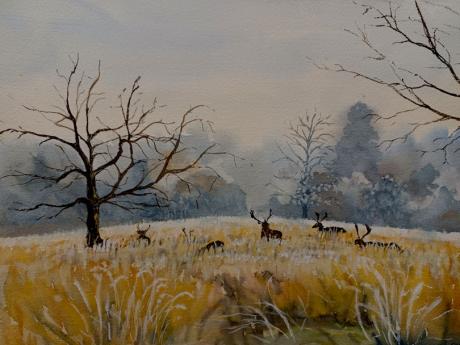" P Yates" and inscribed on the reverse
Unframed
Richmond Park, in the London Borough of Richmond upon Thames, is the largest of London's Royal Parks, and is of national and international importance for wildlife conservation. It was created by Charles I in the 17th century as a deer park. It is now a national nature reserve, a Site of Special Scientific Interest and a Special Area of Conservation and is included, at Grade I, on Historic England's Register of Historic Parks and Gardens of special historic interest in England. Its landscapes have inspired many famous artists and it has been a location for several films and TV series. Richmond Park includes many buildings of architectural or historic interest. The Grade I-listed White Lodge was formerly a royal residence and is now home to the Royal Ballet School. The park's boundary walls and ten other buildings are listed at Grade II, including Pembroke Lodge, the home of 19th-century British Prime Minister Lord John Russell and his grandson, the philosopher Bertrand Russell. In 2020, Historic England also listed two other features in the park – King Henry's Mound which is possibly a round barrow and another (unnamed) mound which could be a long barrow. Historically the preserve of the monarch, the park is now open for all to use and includes a golf course and other facilities for sport and recreation. It played an important role in both world wars and in the 1948 and 2012 Olympics.
In its citation, Natural England said: "Richmond Park has been managed as a royal deer park since the seventeenth century, producing a range of habitats of value to wildlife. In particular, Richmond Park is of importance for its diverse deadwood beetle fauna associated with the ancient trees found throughout the parkland. In addition the park supports the most extensive area of dry acid grassland in Greater London.
In 1625 Charles I brought his court to Richmond Palace to escape an outbreak of plague in London[63] and turned the area on the hill above Richmond into a park for the hunting of red and fallow deer. It was originally referred to as the king's "New Park" to distinguish it from the existing park in Richmond, which is now known as Old Deer Park. In 1637 he appointed Jerome Weston, 2nd Earl of Portland as keeper of the new park for life, with a fee of 12 (old) pence a day, pasture for four horses, and the use of the brushwood – later holders of that office were known as "Ranger". Charles's decision, also in 1637, to enclose the land was not popular with the local residents, but he did allow pedestrians the right of way. To this day the walls remain, although they have been partially rebuilt and reinforced. Following Charles I's execution, custodianship of the park passed to the Corporation of the City of London. It was returned to the restored monarch, Charles II, on his return to London in 1660.
Between 1833 and 1842 the Petersham Lodge estate, and then part of Sudbrook Park, were incorporated into Richmond Park. Terrace Walk was created from Richmond Gate to Pembroke Lodge. The Russell School was built near Petersham Gate in 1851. Between 1855 and 1861, new drainage improvements were constructed, including drinking points for deer. In 1867 and 1876 fallow deer from the park were sent to New Zealand to help build up stocks – the first fallow deer introduced to that country In or around 1870, the Inns of Court Rifle Volunteers were using an area near Bog Gate as a drill ground. Giuseppe Garibaldi, Italian general and politician, visited Lord John Russell at Pembroke Lodge in 1864, as did the Shah of Persia, Naser al-Din Shah Qajar in 1873. He was the first modern Iranian monarch to visit Europe.
Originally created for deer hunting, Richmond Park now has 630 red and fallow deer that roam freely within much of the park. A cull takes place each November and February to ensure numbers can be sustained; about 200 deer are culled annually and the meat is sold to licensed game dealers. Some deer are also killed in road accidents, through ingesting litter such as small items of plastic, or by dogs. Many of the deer in Richmond Park are infected with a bacterium called Borrelia burgdorferi which can be transmitted to humans through a tick bite, causing Lyme disease

